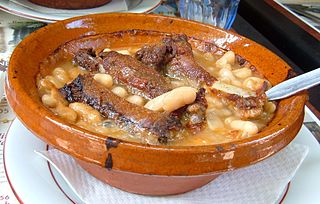Cassoulet
 Cassoulet served in Carcassonne, France, in a casserole sized for single serving | |
| Type | Stew or casserole |
|---|---|
| Place of origin | France |
| Main ingredients | Meat (typically pork sausages, goose, duck, sometimes mutton), pork skin, white haricot beans |
Cassoulet (/ˌkæsəˈleɪ/,[1] also UK: /ˈkæsʊleɪ/,[2] US: /ˌkæsʊˈleɪ/,[3][4] French: [kasulɛ]; from Occitan caçolet [kasuˈlet] (![]() listen) and cognates with Spanish: cazoleja or cazoleta and Catalan: estabousir) is a rich, slow-cooked casserole containing meat (typically pork sausages, goose, duck and sometimes mutton), pork skin (couennes) and white beans (haricots blancs), originating in southern France. It is named after its traditional cooking vessel, the casserole, a deep, round, earthenware pot with slanting sides.[5]
listen) and cognates with Spanish: cazoleja or cazoleta and Catalan: estabousir) is a rich, slow-cooked casserole containing meat (typically pork sausages, goose, duck and sometimes mutton), pork skin (couennes) and white beans (haricots blancs), originating in southern France. It is named after its traditional cooking vessel, the casserole, a deep, round, earthenware pot with slanting sides.[5]
The dish is said to have originated in the town of Castelnaudary, and is particularly popular in the neighboring towns of Toulouse and Carcassonne. It is associated with the region once known as the province of Languedoc.[6] An organization called The Grand Brotherhood of the Cassoulet of Castelnaudary (French: La Grande Confrérie du Cassoulet de Castelnaudary), has organized competitions and fairs featuring cassoulet every year since 1999.[7]
Composition[]
All cassoulets are made with white beans (french: haricots blancs or lingots),[a] duck or goose confit, sausages, and additional meat. In the cassoulet of Toulouse, the meats are pork and mutton, the latter frequently a cold roast shoulder. The Carcassonne version is similar but doubles the portion of mutton and sometimes replaces the duck with partridge.[8] The cassoulet of Castelnaudary uses a duck confit instead of mutton.
In France, cassoulets of varying price and quality are also sold in cans and jars in supermarkets, grocery stores, and delicatessens. The cheapest ones contain only beans, tomato sauce, sausages, and bacon. More expensive versions are likely to be cooked with goose fat and to include Toulouse sausages, lamb, goose, or duck confit.
Haute cuisine versions require mixing pre-cooked roasted meats with beans that have been simmered separately with aromatic vegetables,[9] but this runs counter to cassoulet's peasant origins. In the process of preparing the dish it is traditional to deglaze the pot from the previous cassoulet in order to give a base for the next one. This has led to stories, such as the one given by Elizabeth David, citing Anatole France, of a single original cassoulet being extended for years or even decades.[10]

In U.S. restaurants, the term cassoulet is often applied to any hearty bean-based casserole, with variations such as salmon cassoulet.[11]
See also[]
Notes[]
- ^ White beans replaced the medieval broad bean, Vicia fava.
References[]
- ^ "cassoulet". Merriam-Webster Dictionary. Retrieved 29 May 2019.
- ^ "cassoulet" (US) and "cassoulet". Oxford Dictionaries UK Dictionary. Oxford University Press. Retrieved 29 May 2019.
- ^ "cassoulet". The American Heritage Dictionary of the English Language (5th ed.). Boston: Houghton Mifflin Harcourt. Retrieved 29 May 2019.
- ^ "Cassoulet". Collins English Dictionary. HarperCollins. Retrieved 29 May 2019.
- ^ David, Elizabeth (1999). French Provincial Cooking (7th printing ed.). New York: Penguin Books. pp. 59 and 61. ISBN 0141181532.
- ^ Dryansky, G. Y.; Dryansky, Joanne (2012). "The Southwest Trinity". Coquilles, Calva, & Crème: Exploring France's Culinary Heritage (1st Pegasus Books ed.). New York: Pegasus Books. ISBN 978-1-60598-329-5.
- ^ http://www.feteducassoulet.com
- ^ Grigson, Jane (2001). Charcuterie and French Pork Cookery. London: Grub Street. pp. 163–164. ISBN 9781902304885.
- ^ "Classic Cassoulet". Bon Appétit. Condé Nast. March 2018. Archived from the original on 19 August 2020. Retrieved 19 August 2020.
- ^ David, Elizabeth (1980) [1951]. French Country Cooking (2nd rev. ed. 1965. Reprinted in Elizabeth David Classics ed.). London: Jill Norman. p. 93. ISBN 0906908035.
- ^ Zeldes, Leah A. (13 January 2009). "Eat this! Cassoulet, a hearty winter casserole from Southwestern France". Dining Chicago. Chicago's Restaurant & Entertainment Guide, Inc. Archived from the original on 17 February 2010. Retrieved 13 January 2009.
External links[]
 The dictionary definition of cassoulet at Wiktionary
The dictionary definition of cassoulet at Wiktionary
- French stews
- Occitan cuisine
- Legume dishes
- Sausage dishes
- Casserole dishes